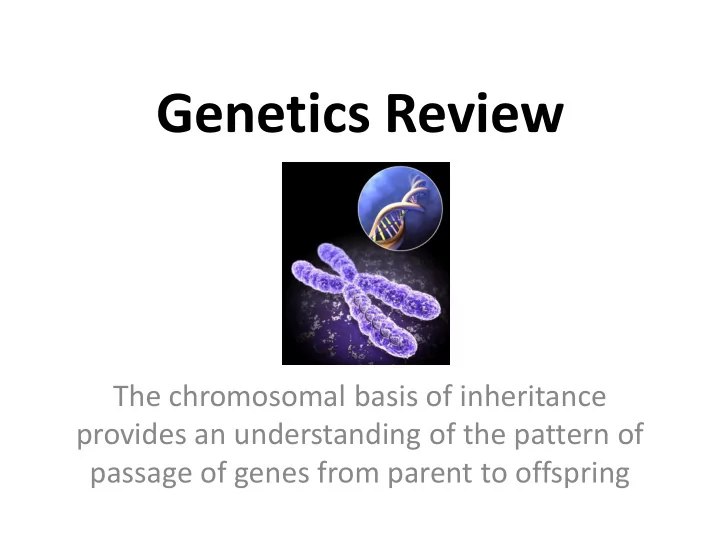

Genetics Review The chromosomal basis of inheritance provides an understanding of the pattern of passage of genes from parent to offspring
Rules of Probability
Rules of Multiplication
Rule of Addition
Mendelian Genetics
Law of Segregation • Pair of alleles for a gene will separate from one another during the formation of gametes
Law of Independent Assortment • Genes on separate chromosomes assort in gametes independently • Due to the random alignment of the chromosomes during Metaphase I of meiosis
Monohybrid Cross
Dihybrid Cross
Beyond Mendel Inheritance patterns that cannot be explained by simple Mendelian genetics
Linked Genes • Genes that are adjacent and close to each other on the same chromosomes tend to be inherited as a unit (linked) • Do not follow Mendel’s laws of independent assortment ( result is unpredictable ratios ) • Probability that genes will separate as a unit is a function of the distance between them
Linked Genes
Chromosome Crossover
Linkage Map • Diagrams describing the relative gene locations using recombination frequencies • The shorter the distance between two genes, the less likely a cross over event will happen between them
Multiple Genes and/or Physiological Processes • Many traits are the product of multiple genes and/or physiological processes • Patterns of inheritance do not follow ratios predicted by Mendel’s laws • These traits can be identified by quantitative analysis where observed phenotypic ratios statistically differ from predicted ratios
Sex-Linked Genes • Gene that determines a phenotype is located on the X or Y chromosome
Incomplete Dominance
Multiple Alleles
Polygenic Inheritance • Shows quantitative variation in a population
Epistasis • A gene at one locus alters the phenotypic expression of a gene at a second locus • Example: Labrador Retriever Coat Color – Black (B) coat color is dominant to chocolate coat color (b) – Pigmentation gene (E/e) is epistatic to the coat color locus
Epistasis
Thomas Hunt Morgan – Fruit Flies (1910) • Discovered the sex chromosomes and determined XX for females and XY for males • Discovered genes located on sex chromosomes
Sex-Limited Genes • The expression of the gene depends on the sex of the individual • Examples: – Milk production in female mammals – Pattern baldness in males
Nonnuclear Inheritance • Organelles are randomly assorted into gametes and daughter cells • Traits determined by chloroplast and mitochondrial DNA do not follow simple Mendelian rules • Animals: mitochondrial DNA is transmitted by the egg ( mitochondrial determined traits are maternally inherited )
Maternal Mitochondrial DNA (mtDNA) • Contains 37 genes • 13 code for enzymes used in oxidative phosphorylation • Others code for tRNA and rRNA molecules
Environmental Impact on Phenotype • Environmental factors influence the expression of the genotype and ultimately the phenotype • Examples: – Flower color based on soil pH – Seasonal fur color in arctic animals – Density of plant hairs (trichomes) as a function of herbivory – Arabinose and the RFP protein
Flower Color Based on Soil pH
Seasonal Fur Color In Arctic Animals • Arctic fox: genes that produce darker pigmentation are blocked by cold temperatures • Spring/summer – brown fur • Winter – white fur
Density of Trichomes as a Function of Herbivory • Trichomes may release acids making in difficult for insects to feed on the plant • Increase herbivory = Plant produces more trichomes
Coming soon to a lab near you….. Arabinose and the RFP Protein
Genomes are Flexible • Adaptations to the local environment reflects a flexible response of an organisms genome • Examples: – Darker fur in cooler regions of the body in mammals – Alterations in timing of flowering due to climate changes
Himalayan Rabbits • Cooler temperatures = dark fur • Warmer temperatures = white fur
Flowering and Climate Change • Flowering plants have gradually begun blooming earlier as average temperature rise • Longer growing seasons, but most plants rely on a certain period of “cooling” temperatures to function properly in the spring
Recommend
More recommend